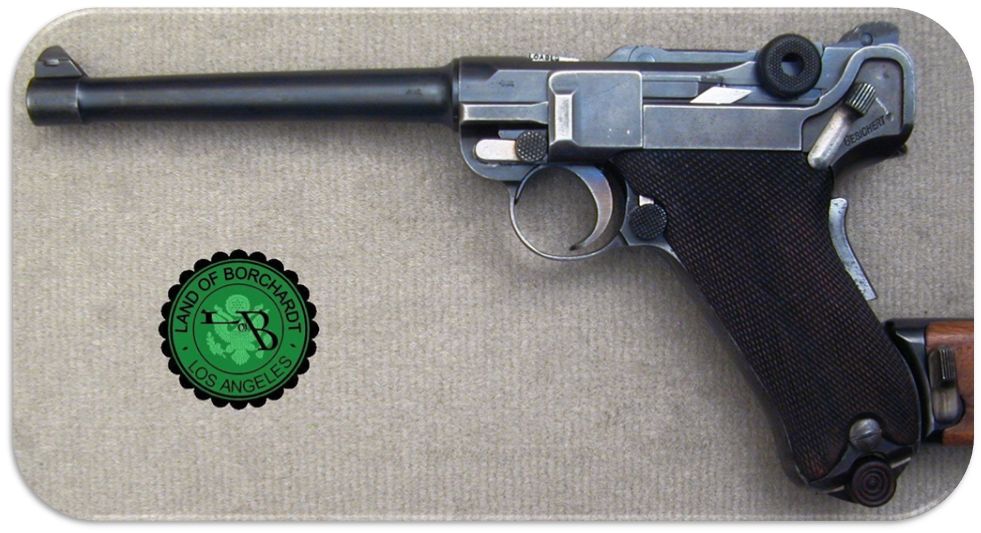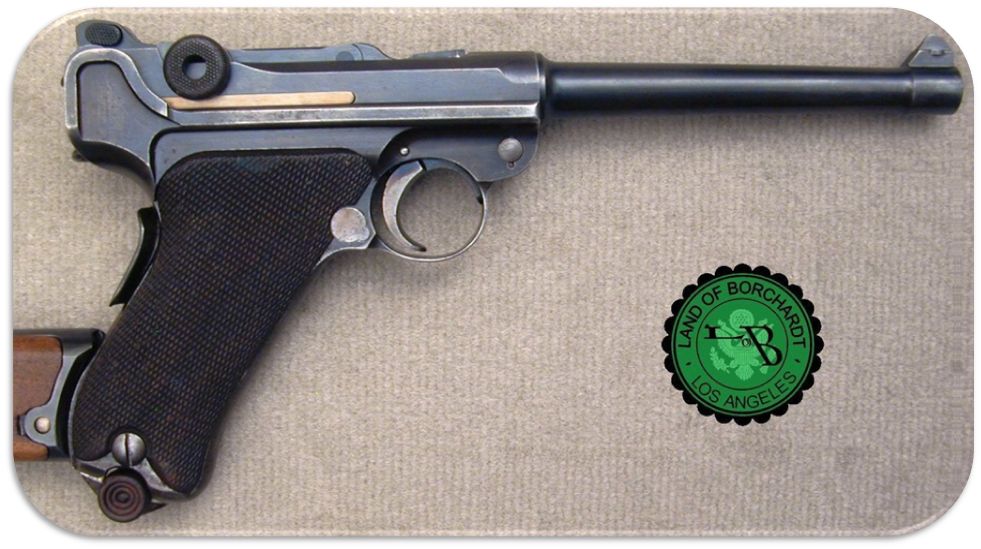buttons

 This Navy is almost certainly a post WWI parts assembly gun put up by or for Stoeger, as the very nice holster suggests.
This Navy is almost certainly a post WWI parts assembly gun put up by or for Stoeger, as the very nice holster suggests.  The stock is identical to
that with my Stoeger cased navy 74i, having a crown/M mark to the blank disc, indicating it was a Navy accepted spare part originally.
The stock is identical to
that with my Stoeger cased navy 74i, having a crown/M mark to the blank disc, indicating it was a Navy accepted spare part originally.  The receiver must have been made before 1909-10 when the pin wheel inspection mark disappeared,
The receiver must have been made before 1909-10 when the pin wheel inspection mark disappeared,  and the unmarked frame well is typical of first contract military Navy pistols of 1905-6 manufacture, as later guns of the second delivery and commercial P.04 have the flaming bomb mark in the well.
and the unmarked frame well is typical of first contract military Navy pistols of 1905-6 manufacture, as later guns of the second delivery and commercial P.04 have the flaming bomb mark in the well.  The up-safe/lower GESICHERT safety is also of this period, so I'd suggest the gun started life as un-serialled spare parts of this period and was assembled after WWI for Stoeger in the early period of their agency before the Versailles Treaty prohibitions took effect.
The up-safe/lower GESICHERT safety is also of this period, so I'd suggest the gun started life as un-serialled spare parts of this period and was assembled after WWI for Stoeger in the early period of their agency before the Versailles Treaty prohibitions took effect.  The anomalous proofing is fairly typical of the chaotic appearance of guns made in 1919 - 1921, when positions and orientation of the crown/N commercial proof and whether it was applied or not seem somewhat random.
The anomalous proofing is fairly typical of the chaotic appearance of guns made in 1919 - 1921, when positions and orientation of the crown/N commercial proof and whether it was applied or not seem somewhat random.
The above description is from Dr. G.L. Sturgess; the following is a further detailed description of the purportedly A.F. Stoeger, Inc. no-serial-number commercial navy rig or ensemble, consisting of the gun, holster, and navy board stock with some background information.
Background
A.F. Stoeger, Inc. was established in 1919,  placed its first documented order of Lugers and accessories from DWM in June 1921 with the very first shipment from DWM renamed BKIW, arriving in October 1922.[1] The first A.F. Stoeger, Inc. catalog was published in New York, September 15, 1924
placed its first documented order of Lugers and accessories from DWM in June 1921 with the very first shipment from DWM renamed BKIW, arriving in October 1922.[1] The first A.F. Stoeger, Inc. catalog was published in New York, September 15, 1924  with the first appearance of the Stoeger Auerhahn logo in the cover with a copyright date of: © A.F.S. 1924.
with the first appearance of the Stoeger Auerhahn logo in the cover with a copyright date of: © A.F.S. 1924.
The no-serial-number new model, long frame grip safety commercial navy Luger – a mechanical description.

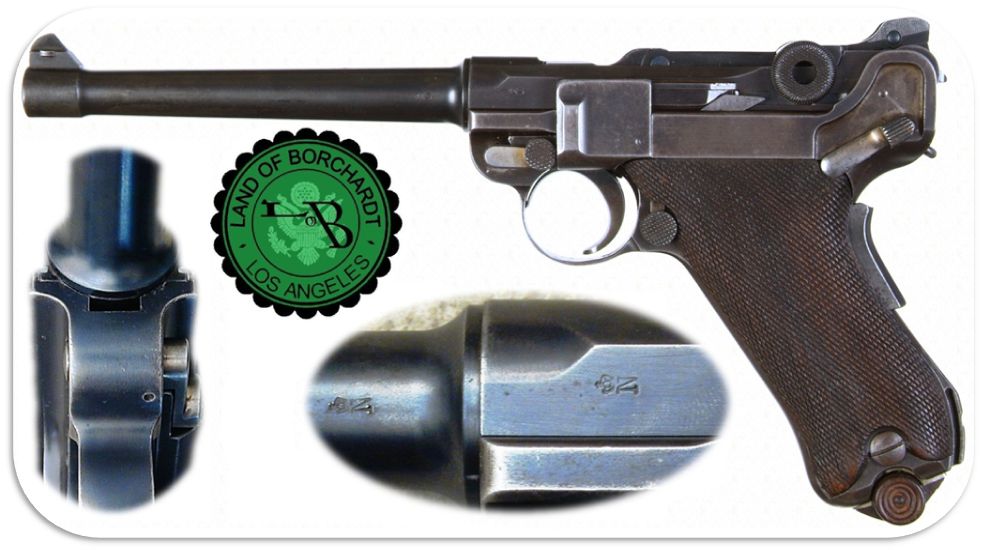
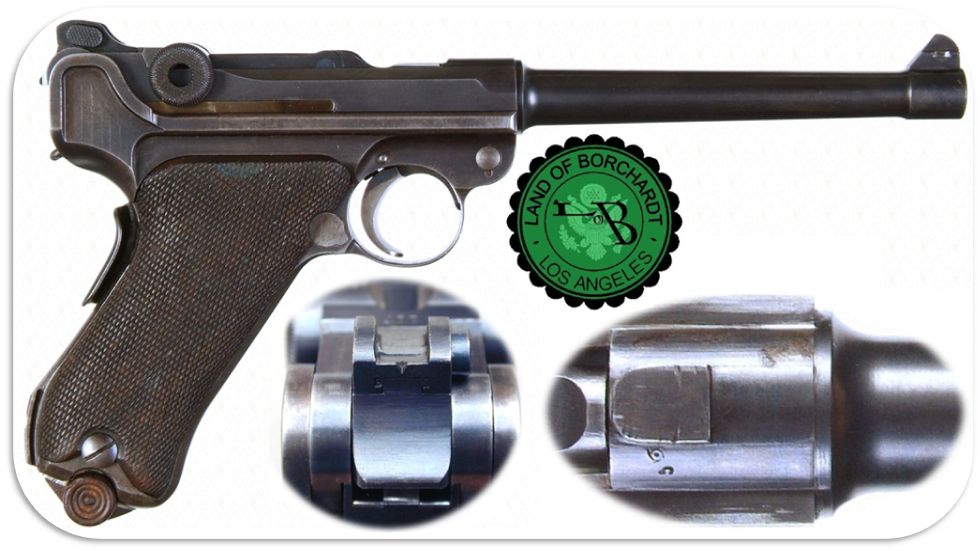
The barrel and receiver are circa 1911 – 1921 lazy crown N or nitro commercial proofed  with
the receiver proof clearly stamped, prior to bluing, including the
with
the receiver proof clearly stamped, prior to bluing, including the  receiver underside pinwheel inspection mark, while the
receiver underside pinwheel inspection mark, while the  barrel proof is stamped through the blue, which is standard for a DWM assembled Luger, except for the unusual location of the barrel proof on the barrel left side, normally located on the barrel underside, curiously, in the same location of
the navy military crown M stamping.
barrel proof is stamped through the blue, which is standard for a DWM assembled Luger, except for the unusual location of the barrel proof on the barrel left side, normally located on the barrel underside, curiously, in the same location of
the navy military crown M stamping.  There are no barrel/receiver witness marks, with explanations for the lack thereof presented herein. The frame, receiver and barrel are certainly of pre-WW1 DWM manufacture, having the characteristics of the first Navy contract batch of 8000 delivered in early 1906, with the exception of the toggle link assembly which is a 1919 – 1921 assembly, consisting of a 1917 – 1918 inspection stamped DWM production spare middle link and a breechblock with
LOADED stamped extractor.
There are no barrel/receiver witness marks, with explanations for the lack thereof presented herein. The frame, receiver and barrel are certainly of pre-WW1 DWM manufacture, having the characteristics of the first Navy contract batch of 8000 delivered in early 1906, with the exception of the toggle link assembly which is a 1919 – 1921 assembly, consisting of a 1917 – 1918 inspection stamped DWM production spare middle link and a breechblock with
LOADED stamped extractor.  The 100 – 200 meter un-serialized navy rear link is a WW1, un-serialized spare.
The 100 – 200 meter un-serialized navy rear link is a WW1, un-serialized spare.  There is not a solitary serial number on the frame or barrel,
There is not a solitary serial number on the frame or barrel,  or any of the small parts, including the wooden grips. Various theories are presented to explain this.
or any of the small parts, including the wooden grips. Various theories are presented to explain this.  Additionally the magazine and the holster spare magazine are of the navy style with the concentric circles in the wooden bottom grasping knobs with no numbers or stylized Cal 9mm stamping on the wooden bottoms, although the gun magazine body is of Erfurt
manufacture and the holster spare magazine, while of the correct pre-WW1 magazine body, the wooden bottom retaining pin may not be original.
Additionally the magazine and the holster spare magazine are of the navy style with the concentric circles in the wooden bottom grasping knobs with no numbers or stylized Cal 9mm stamping on the wooden bottoms, although the gun magazine body is of Erfurt
manufacture and the holster spare magazine, while of the correct pre-WW1 magazine body, the wooden bottom retaining pin may not be original.
Arguments in favor of a 1919–1921 parts assembly: Regarding the subject Navy Luger is concerned, it is the absence of any serial numbered parts that indicates it is a spare parts assembly, as the serial numbers were applied to parts at an early stage in assembly to keep the parts together after initial fitting, before proofing, not after proofing and finishing etc. This is true of both military and commercial assemblies, so there are grave doubts that the gun was assembled by DWM on their normal production line, as they would have applied serial numbers as a matter of course, and this also rules out pre-WWI assembly. In the conditions applying in the factory in 1919 - 1921, all sorts of aberrations are seen, and it is possible it was assembled there as a special order from spares for a Stoeger order, and the C/N proofing seems to indicate this, but proofed parts were kept as spares, and no additional proofing was applied after assembly, so the C/N marks are not conclusive of factory assembly, as it could equally well have been assembled from proofed parts by a third party such as Stoeger.
---------------- page 2 ---------------
Mirror Image Transference
Alternate arguments in favor of pre-WW1 assembly: Based on a preliminary examination, the new model 1906 commercial lazy crown N proofed navy Luger, devoid of any serial numbers whatsoever, appears to be assembled using mostly, pre-WW1 unused spare parts. This includes  an early contract, unaltered lower Gesichert stamped unreinforced, pre-1914 frame with
an early contract, unaltered lower Gesichert stamped unreinforced, pre-1914 frame with  no DWM factory inspection marks in the forward frame lug well, also with a pre-WW1 DWM factory pinwheel inspection stamped receiver underside, adjacent to the no-serial-number stop lug, with an installed 150 mm navy 9mm barrel, without the normally expected barrel/receiver interface “alignment” witness marks; all mentioned parts with no serial number.
no DWM factory inspection marks in the forward frame lug well, also with a pre-WW1 DWM factory pinwheel inspection stamped receiver underside, adjacent to the no-serial-number stop lug, with an installed 150 mm navy 9mm barrel, without the normally expected barrel/receiver interface “alignment” witness marks; all mentioned parts with no serial number.  Curiously, the inside of the side-plate appears to have never been blued, or possibly removed, for reasons unknown, as compared to a typical period production side plate, although the lower edge of the tang shows evidence of original bluing vs. the normal, albeit dull rust blue finish of the outside side-plate surface.
Curiously, the inside of the side-plate appears to have never been blued, or possibly removed, for reasons unknown, as compared to a typical period production side plate, although the lower edge of the tang shows evidence of original bluing vs. the normal, albeit dull rust blue finish of the outside side-plate surface.
Both the barrel and the receiver are stamped on the left side with the circa 1911 – 1921 lazy crown N or nitro commercial proof. The toggle link assembly has been determined to be a replacement, based on the following information, centered on a condition, for lack of another definition, called “Mirror Image Transference”.
The toggle knob undersides of the old model and into the early production new model, to about 1909, are regularly found with a single digit factory inspection number stamped on the toggle knob flat undersides, either the left or right side. This single digit number, which can be any number from 0 to 9, can, after time, of either continuous firing or with the toggle link assembly, at rest on top of the receiver forks or rails for many years, will leave a mirror image impression of the number on the corresponding receiver rail top surface, thus forever associating the original toggle link assembly and receiver as original to each other.  Pictured is one such example, a 1906, very early contract, new model production navy Luger serial number 307 which, coincidently, has the same pre-1914 unreinforced frame and pinwheel stamped receiver and unstamped,
Pictured is one such example, a 1906, very early contract, new model production navy Luger serial number 307 which, coincidently, has the same pre-1914 unreinforced frame and pinwheel stamped receiver and unstamped,  no serial number trigger as the completely no-serial-number subject lazy crown N grip safety commercial navy Luger.
no serial number trigger as the completely no-serial-number subject lazy crown N grip safety commercial navy Luger.
 Upon a close and detailed examination of the subject no-serial-number navy Luger, revealed a Mirror Image Transfer number on the receiver top rear left side rail, being a single digit number 2 DWM factory inspection mark, however, with no original DWM factory stamped inspection number on the no-serial-number rear toggle link assembly toggle knob flat undersides. This lack of no corresponding number, combined with no evidence of toggle knob contact with the frame cam ramps or the top of the receiver, clearly indicates that the toggle link assembly is not original to the gun and additionally, based on the middle link underside inspection marks, defines the toggle link assembly as a 1919 – 1921 replacement with a
Upon a close and detailed examination of the subject no-serial-number navy Luger, revealed a Mirror Image Transfer number on the receiver top rear left side rail, being a single digit number 2 DWM factory inspection mark, however, with no original DWM factory stamped inspection number on the no-serial-number rear toggle link assembly toggle knob flat undersides. This lack of no corresponding number, combined with no evidence of toggle knob contact with the frame cam ramps or the top of the receiver, clearly indicates that the toggle link assembly is not original to the gun and additionally, based on the middle link underside inspection marks, defines the toggle link assembly as a 1919 – 1921 replacement with a  breechblock with LOADED marked extractor,
breechblock with LOADED marked extractor,  based on the rear breechblock face, two-digit number and corresponding extractor underside tang, two-digit number.
based on the rear breechblock face, two-digit number and corresponding extractor underside tang, two-digit number.
This DWM factory breechblock-extractor numbering system is first seen on Luger pistols in the 1919 – 1921 period of production, continuing through the late 1920s, although not always necessarily matching and not associated with the gun serial number, generally are the same, although, in this case do not agree with the rear breechblock face, being stamped 84 and the LOADED marked extractor underside tang stamped 58, suggesting replacement of the original 84 stamped Geladen extractor, possibly to satisfy Stoeger requirements, which is confusing as why use an existing 1919 – 1921 made underside tang stamped 58, LOADED marked extractor made for or from an existing breechblock?
The middle link is of 1917 – 1918 production  with a pre-WW1, un-serialized 100 – 200 meter adjustable navy spare rear link. Regarding the configuration of the original replaced toggle link assembly, the only thing known is that the rear link toggle knob flat surface was DWM factory inspection stamped with the number 2, making it of 1909 or earlier manufacture. Any information as to whether the original toggle link assembly was serialized or not, is lost to history, although it is pretty much certain, based on the
balance of the gun that it was not serialized, although the extractor could have been Geladen stamped.
with a pre-WW1, un-serialized 100 – 200 meter adjustable navy spare rear link. Regarding the configuration of the original replaced toggle link assembly, the only thing known is that the rear link toggle knob flat surface was DWM factory inspection stamped with the number 2, making it of 1909 or earlier manufacture. Any information as to whether the original toggle link assembly was serialized or not, is lost to history, although it is pretty much certain, based on the
balance of the gun that it was not serialized, although the extractor could have been Geladen stamped.
One can say, therefore, without contradiction, that the
subject navy Luger has not been fired, or fired very little,  since the installation of the second replacement toggle link assembly and with the well-used condition of the balance of the gun, no doubt, incurred prior to the installation of the virtually, unused condition of the 1919 – 1921 assembled replacement toggle link assembly, and that this gun may not have been exported in this configuration in the immediate post war period, which leaves for endless speculation and opining as to the original time frame current toggle link assembly origins.
since the installation of the second replacement toggle link assembly and with the well-used condition of the balance of the gun, no doubt, incurred prior to the installation of the virtually, unused condition of the 1919 – 1921 assembled replacement toggle link assembly, and that this gun may not have been exported in this configuration in the immediate post war period, which leaves for endless speculation and opining as to the original time frame current toggle link assembly origins.
---------------- page 3 ---------------
If, for example, the subject navy Luger had been located with the original pre-WW1 toggle link assembly with the numeral 2 DWM inspection mark on the toggle knob underside, an inspection stamped location as stated above, discontinued about 1909, which for all practical purposes, based on Mirror Image Transference evidence, is the original configuration as originally manufactured, would be, and is, a very compelling argument, strongly erring toward 1911 or later pre-WW1 manufacture, despite the lack of serialization and lack of barrel/receiver witness marks. Conversely, it would be very difficult to define it as a 1920s assembled “parts” gun, based on the existing replacement toggle link assembly and other issues cited.
In the above scenario there is a tendency to mistakenly assume that, since the main components of the gun are of pre-WW1 manufacture, to conclude that the entire gun was assembled in that pre-WW1 time frame,
ignoring all other aspects of the gun. As to why, where, or when the toggle link assembly was replaced, hopefully for purely ethical motives, may never be known, however, is not as important than the fact that  the current toggle link assembly is totally correct in its configuration, with its LOADED stamped extractor, a Stoeger hallmark item, never being modified or tampered with, being a 1919 – 1921 assembly as described above.
the current toggle link assembly is totally correct in its configuration, with its LOADED stamped extractor, a Stoeger hallmark item, never being modified or tampered with, being a 1919 – 1921 assembly as described above.
 One unexplained condition is the additional wear on the top of the receiver forks, extending 1.5-2mm, just forward of the toggle knobs, which is similar to the expected receiver forks top surface area wear directly under the toggle knobs, resulting from the repeated slamming of the toggle knob undersides against the receiver fork surface from many firing cycles.
One unexplained condition is the additional wear on the top of the receiver forks, extending 1.5-2mm, just forward of the toggle knobs, which is similar to the expected receiver forks top surface area wear directly under the toggle knobs, resulting from the repeated slamming of the toggle knob undersides against the receiver fork surface from many firing cycles.  This additional wear patch does not appear to be related to the use of a sub-caliber device, such as the toggle of the ERMA SE-08 does not lock, the center pivot being held above the joint line between the two outer pivots by the design of the toggle links, and the toggle grips never contact the top of the receiver. Since the contact area between the normal toggle grips and the receiver is fixed by the presence of the rear pivot, there is no “current” explanation for this additional wear patch.
This additional wear patch does not appear to be related to the use of a sub-caliber device, such as the toggle of the ERMA SE-08 does not lock, the center pivot being held above the joint line between the two outer pivots by the design of the toggle links, and the toggle grips never contact the top of the receiver. Since the contact area between the normal toggle grips and the receiver is fixed by the presence of the rear pivot, there is no “current” explanation for this additional wear patch.  However, with an ERMA 22 Cal sub caliber conversion unit toggle link assembly inserted in the receiver, the flat 4 mm front-to-rear length underside, small diameter “toggle grips” conveniently set over the forward surface additional wear area.
However, with an ERMA 22 Cal sub caliber conversion unit toggle link assembly inserted in the receiver, the flat 4 mm front-to-rear length underside, small diameter “toggle grips” conveniently set over the forward surface additional wear area.  This is also demonstrated in a 1939 Stoeger catalog advertisement for the first Stoeger offered “Luger .22 Caliber Insert and Accessories” showing the toggle insert assembly seating flush to the receiver.
This is also demonstrated in a 1939 Stoeger catalog advertisement for the first Stoeger offered “Luger .22 Caliber Insert and Accessories” showing the toggle insert assembly seating flush to the receiver.
Since the “self-loading” 22 caliber conversion units were only first introduced in the mid to late 1920s and only for the military and Police, and if the additional wear patch on the subject commercial navy receiver are from such a device, could only have occurred, at the earliest in the early 1930s as a commercial offering, suggests that the use of the .22 caliber self-loading assembly, obviously required the original toggle link assembly to be set aside and possibly misplaced by the owner, subsequently with the gun ending up with the current toggle link assembly in the 1930s or later, being naturally, a Stoeger no-serial-number replacement assembly. Interestingly, as stated above, the Stoeger commercial .22 caliber insert assemblies weren’t introduced until 1939.
The 1924 catalog does advertise barrel/receiver assemblies and there are many Luger identified barrel/receiver assemblies with A.F. Stoeger stamped receivers, although the first order, while stating 2500 Lugers and 300 barrels, does not specify receivers, though Stoeger certainly received many A.F. Stoeger, Inc. stamped receivers as A.F. Stoeger stamped, complete Luger pistol receiver/barrel assemblies, as many barrel lengths exists, assembled by Stoeger, who states in their first issue 1924 catalog that they have the capabilities to change, remove or install barrels.  These barrel/receiver assemblies are pictured in the first year printing of the 1924 catalog on page 27, probably sample assemblies made for the catalog.
These barrel/receiver assemblies are pictured in the first year printing of the 1924 catalog on page 27, probably sample assemblies made for the catalog.
That the subject navy Luger commercial lacks the A.F. Stoeger, Inc. stamped receiver, interestingly, also lacking any Germany export stamp, dates the gun as not of the first Stoeger contract with A.F. Stoeger, Inc. stamped receivers, and although the no-serial-number, new model 1906 grip safety navy Luger may have been exported in the 1919 – 1921 time frame, possibly by Stoeger, does not mean that the gun was assembled in that time frame as a 1920s parts gun. The fact that the frame has been determined to be an early 1906 grip safety navy production, unaltered Gesichert stamped frame and the receiver also, based on the circa 1906 – 1909 time frame use of the DWM factory pinwheel inspection mark, to be of the same period, combined with the circa 1911 – 1921 lazy crown N receiver and barrel proof, notwithstanding the lack of serial numbers, which would normally be the third step after the gun was assembled, tested, proofed and blued before serial numbers were applied, errs toward the manufacture of this gun to 1911 – 1914, ergo a pre-WW1 Model 1906 lazy N commercial proofed navy Luger.
There are equally compelling arguments against the above presented scenario, for the origins of the subject navy Luger, with one such discussion  revolving around the lack of witness “alignment” marks on the receiver underside and barrel flange, suggesting assembly by A.F. Stoeger., Inc. in the early 1920s: The initial assembly does not depend upon the witness mark at all. The barrels and receivers were all machined and separately gauged to be identical, so any barrel will fit any receiver (of the same threaded portion length) and maintain both head spacing and foresight alignment. Otherwise servicing by barrel replacement, which is common, in the field workshops would be impossible without facilities to machine the foresight bed after breeching up. The assembly method was to tighten the barrel into the receiver until the foresight bed aligned perfectly horizontal and check the headspace. At this point the witness mark was struck so that the barrel could be re-aligned if ever disassembled - but this has no bearing on the initial assembly.
revolving around the lack of witness “alignment” marks on the receiver underside and barrel flange, suggesting assembly by A.F. Stoeger., Inc. in the early 1920s: The initial assembly does not depend upon the witness mark at all. The barrels and receivers were all machined and separately gauged to be identical, so any barrel will fit any receiver (of the same threaded portion length) and maintain both head spacing and foresight alignment. Otherwise servicing by barrel replacement, which is common, in the field workshops would be impossible without facilities to machine the foresight bed after breeching up. The assembly method was to tighten the barrel into the receiver until the foresight bed aligned perfectly horizontal and check the headspace. At this point the witness mark was struck so that the barrel could be re-aligned if ever disassembled - but this has no bearing on the initial assembly.
---------------- page 4 ---------------
The Holster
 The holster, assuming an otherwise un-tampered with Artillery Luger holster, started as
The holster, assuming an otherwise un-tampered with Artillery Luger holster, started as  an Imperial Army Depot Artillery spare, based solely on
an Imperial Army Depot Artillery spare, based solely on  the inside cover flap markings, was converted by or for Stoeger to fit a 1906 grip safety 1919 - 1921 commercial lazy N proofed or later vertical crown N navy Luger. This was accomplished by
the inside cover flap markings, was converted by or for Stoeger to fit a 1906 grip safety 1919 - 1921 commercial lazy N proofed or later vertical crown N navy Luger. This was accomplished by  removing the Artillery cleaning rod leather pouch,
removing the Artillery cleaning rod leather pouch,  adding a magazine pouch in the same location, and shortening the holster from 180mm for the Artillery barrel to 150mm for the navy barrel. This was done by simply removing approximately 30mm from the tip, folding over the front surface of the cut leather and stitching to the back, creating a new closed toe section.
adding a magazine pouch in the same location, and shortening the holster from 180mm for the Artillery barrel to 150mm for the navy barrel. This was done by simply removing approximately 30mm from the tip, folding over the front surface of the cut leather and stitching to the back, creating a new closed toe section.  Since there wasn’t quite enough materiel or cut too short, the new toe, when looking at the holster toe in profile, has a pronounced outward curl.
Since there wasn’t quite enough materiel or cut too short, the new toe, when looking at the holster toe in profile, has a pronounced outward curl.  The horizontal positioned leather cross-strap on the holster rear was removed and an A.F. Stoeger, Inc. Auerhahn logo stamped belt loop with border piping was attached, using a copper rivet and washer at the top, folding over the loop and securing the lower angled end, also with a copper washer and rivet.
The horizontal positioned leather cross-strap on the holster rear was removed and an A.F. Stoeger, Inc. Auerhahn logo stamped belt loop with border piping was attached, using a copper rivet and washer at the top, folding over the loop and securing the lower angled end, also with a copper washer and rivet.
The rework was very professionally done, requiring a master leather maker, in this case a strong possibility being The George W. Lawrence Company of Portland, Oregon. This theory is compelling as Lawrence was one of the first holster suppliers to A.F. Stoeger, Inc. as there are clearly identified Lawrence holsters with the A.F. Stoeger, Inc. Auerhahn logo,  for both the Luger and
for both the Luger and  other period pistols. However, Stoeger did have a comprehensive gun smithing outfit, and modifying the holsters may have been done by Stoeger or any competent saddler in NYC. Pictured below are three such Stoeger/Lawrence holster examples.
other period pistols. However, Stoeger did have a comprehensive gun smithing outfit, and modifying the holsters may have been done by Stoeger or any competent saddler in NYC. Pictured below are three such Stoeger/Lawrence holster examples.
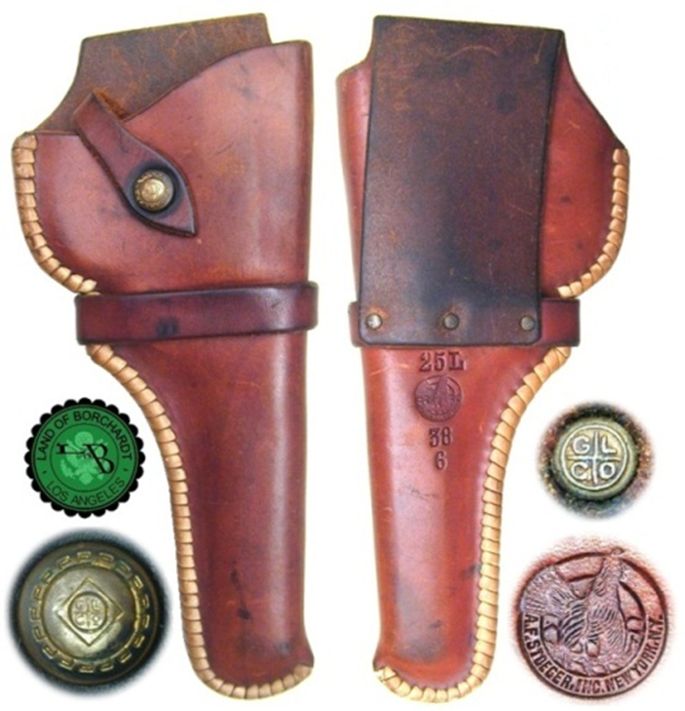
Example 1
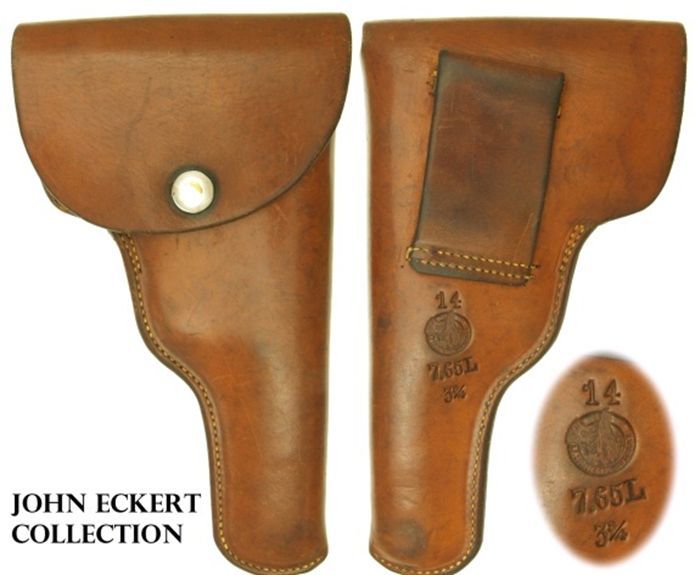
Example 2
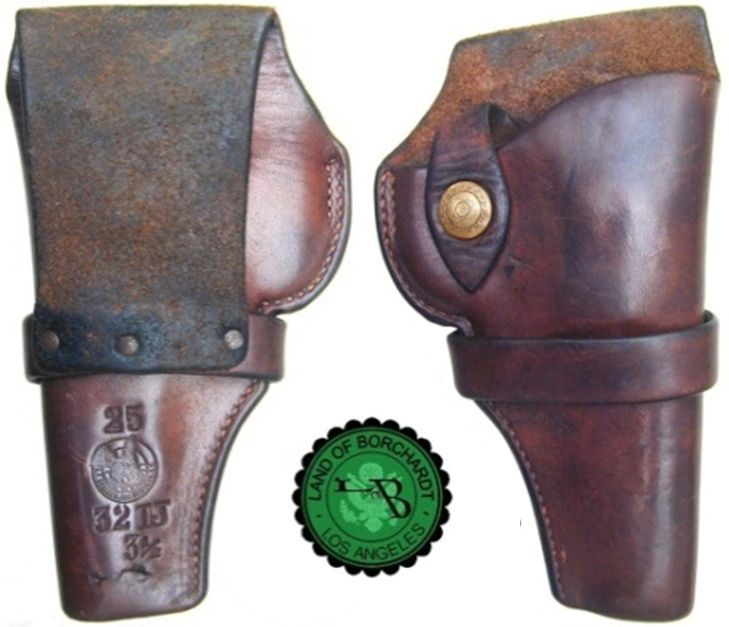
Example 3
 The only other example, pictured in Benders book has been located and is pictured herein.
The only other example, pictured in Benders book has been located and is pictured herein.  The holster cover flap is configured slightly different, using an added snap fastener closure
method, rather than
The holster cover flap is configured slightly different, using an added snap fastener closure
method, rather than  the subject holster which uses the original strap slit and brass stud closure, suggesting, possibly, that these holsters were all not modified at the same time.
the subject holster which uses the original strap slit and brass stud closure, suggesting, possibly, that these holsters were all not modified at the same time.  An example being the belt loop applied Stoeger Auerhahn logo is upside down on the LOB holster vs. right side up on the Eckert holster,
An example being the belt loop applied Stoeger Auerhahn logo is upside down on the LOB holster vs. right side up on the Eckert holster,  pictured herein and originally in
pictured herein and originally in  Luger Holsters and Their Accessories on page 619 by E. Bender.
Luger Holsters and Their Accessories on page 619 by E. Bender.
Given the comparative rarity of commercial navy P.04 and LP.08 Artillery Lugers, for which U.S. commercial holsters of these patterns would be logical purchases, it shows how many ex-military P.04s and LP.08s must have been carried around as sport or plinking guns before they became collector's items. Pictured below are several such U.S. made Artillery Luger holsters
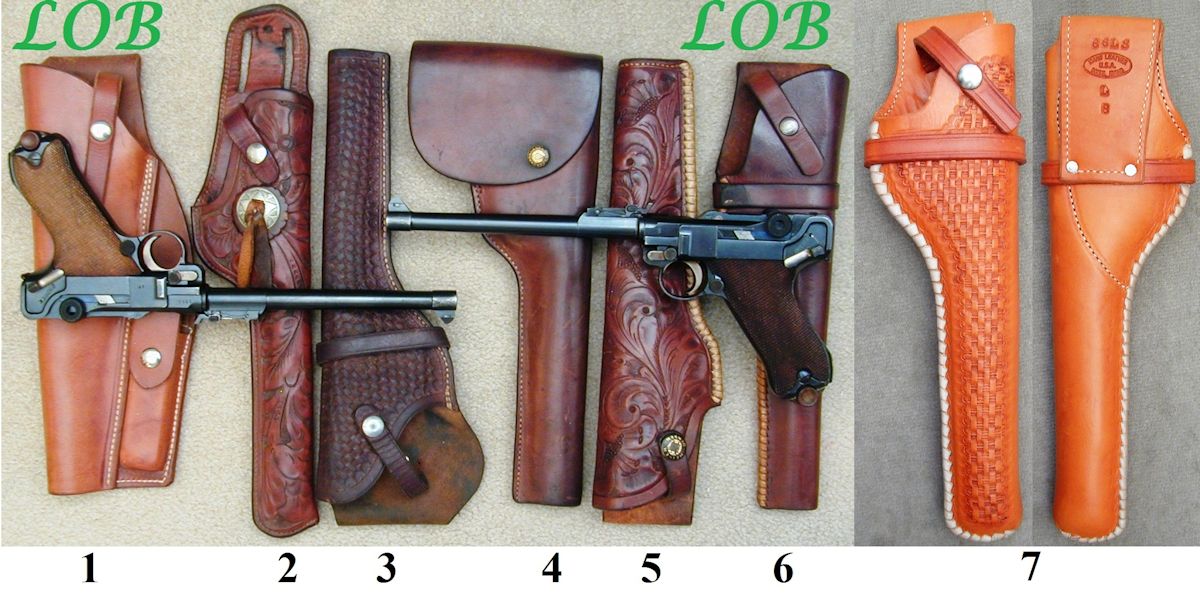
2) 1940 – 1950 Colorado Saddlery, Denver, style 1917 open top, hanging belt loop, safety strap, closed toe, very fancy full Mexican hand carved, western style commercial holster for Artillery Luger.
3) 1950s unknown holster maker, basket weave pattern, belt loop, open top, safety strap, open toe, commercial holster for Artillery Luger.
4) The Geo. Lawrence Co, Portland, Ore. “Steerhide” football logo, full cover flap, open toe, style 14 9 MM 8 for Artillery Luger.
5) 1920 – 1930 Heiser HHH Denver logo style 722, hand marked Luger 8, open top, safety strap, toe plug, described, but not pictured in Heiser catalog as: Thong Wrap Stitched Edge. No.722––Full Mexican hand carved.
6) 1920 – 1930 Heiser HHH Denver logo style 422, hand marked Luger 8, open top, safety strap, toe plug, described in 1920s Heiser catalog as: Thong Wrap Stitched Edge. No.422––All plain smooth finish.
---------------- page 5 ---------------
7) 1980s Idaho Leather Artillery Luger holster with IDAHO LEATHER – U.S.A. – BOISE IDAHO stamped in oval logo cartouche & style No. 66LS stamped above the logo and L 8 below the logo with, belt loop, open top, safety strap, closed toe, commercial holster with a basket weave pattern holster body.

plus a very few identified U.S. commercial navy Luger holsters.

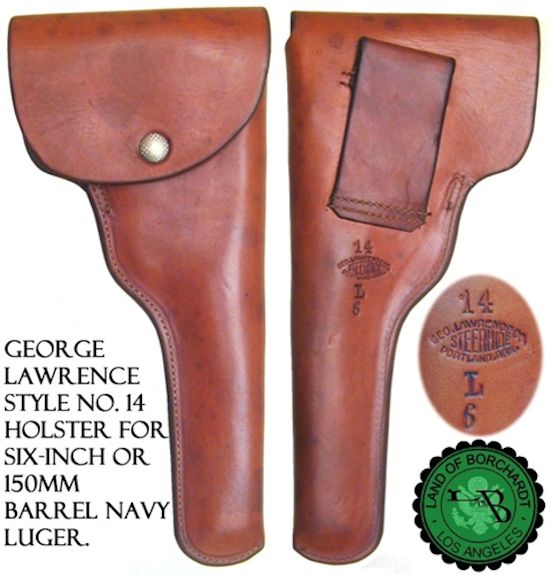
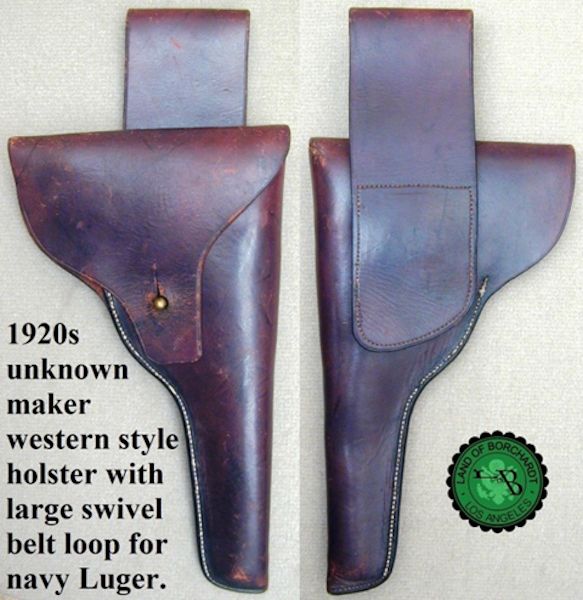
The navy used spare board stock.
The navy spare board stock is indeed a very scarce WW1 Luger accessory, rarely offered for sale and the only other published picture, albeit in black and white was in 1958, fifty four years ago, more than half a century,  on page 263 of Luger Variations by Harry Jones. The description caption is quite accurate and is used here with some corrective inserts: The stock is 12¾ inches long:
on page 263 of Luger Variations by Harry Jones. The description caption is quite accurate and is used here with some corrective inserts: The stock is 12¾ inches long:  the attaching “iron” does not have any part of the gun’s serial number.
the attaching “iron” does not have any part of the gun’s serial number.  A brass disk of one-inch diameter is recessed and held in place with a spanner-screw in the left side of the stock
A brass disk of one-inch diameter is recessed and held in place with a spanner-screw in the left side of the stock  (most discs are steel): this disk has (Imperial) Naval Proofing and a few have an issue number. Stocks for the Commercial Navels do not have this disk and are unmarked: the stock is without a serial number. The rear portion of these stocks are 9/16-inch wide: the front is stepped-up to 11/16-inch.
(most discs are steel): this disk has (Imperial) Naval Proofing and a few have an issue number. Stocks for the Commercial Navels do not have this disk and are unmarked: the stock is without a serial number. The rear portion of these stocks are 9/16-inch wide: the front is stepped-up to 11/16-inch.
However, the Jones pictured navy board stock has an unused toe strap pilot hole, whereas  the subject navy board stock has a threaded or used pilot hole,
the subject navy board stock has a threaded or used pilot hole,  combined with evidence of the board once having shoulder straps suggests a complete, possibly issued, WW1 spare board stock holster configuration,
combined with evidence of the board once having shoulder straps suggests a complete, possibly issued, WW1 spare board stock holster configuration,  based on the un-serialized attaching iron. It is possible, that in addition to the special Stoeger modified holster accessory that the navy board stock was part of the original triage, despite the less used condition, meaning merely that it wasn’t used
much.
based on the un-serialized attaching iron. It is possible, that in addition to the special Stoeger modified holster accessory that the navy board stock was part of the original triage, despite the less used condition, meaning merely that it wasn’t used
much.  Pictured are close up views of the navy spare board stock connected to the no-serial-number lazy N proofed commercial proofed navy Luger.
Pictured are close up views of the navy spare board stock connected to the no-serial-number lazy N proofed commercial proofed navy Luger.
Additional thoughts: The crown/M acceptance stamp was only used up to 1918, and not at all thereafter - the fact that it has Navy acceptance indicates that it was in navy arsenal stocks before 1918, and the lack of an attaching iron serial number, again shows it to have been a spare. If it was used by the Navy, it would not necessarily have been serialized when issued as a replacement part. It may, alternatively, have originally had a navy pattern holster and toe ring fitted when imported by Stoeger, which has subsequently been removed - either is a perfectly logical explanation for the lack of a serial number, the acceptance mark and the fact that the screw pilot hole has been used.
G.L. Sturgess opinions and conjecture
All sorts of variations of re-worked guns, re-barreled guns, spare parts assemblies etc. are found in this period, and I think DWM took the opportunity, while the parts production was not running (employees fell to a total of around 3-400 at this time, so the 800 plus machine tools for parts manufacture could not have been working, except intermittently in 1919/20) to clear out the stock rooms and parts bins by assembling what they could to keep the skilled assembly staff occupied. I also think that during this period, when the treaty terms were known, but not enforced, they disguised the date of production of commercial guns with long barrels or 9 mm caliber which would be prohibited by the Versailles Treaty with these "funny" 1 - 4 digit numbers,  or no number, rather than the regular 5 digit numbers, which are by and large "legal" 7.65/98 mm barreled, most of the later part of the 8xxxx -9xxxx range being early Stoeger Safe/loaded guns. When production recommenced for the Reichswehr and Police with the 9/100 mm P.08s with 1920 and 1921 chamber dates, the parts production also recommenced, and commercial production was regularized in the late 5 digit range. I think that towards the end of the 5
digit range, when treaty enforcement was looming in mid-1921, they started for a short period allocating random 1-3 digit, i suffix numbers to the "illegal" funnies, such as my pair of cased Stoegers 74i and 246i in anticipation of changing to the 4 digit+ suffix system at 92000 = 2000i. Possibly these random early i suffix numbers were used up retrospectively after i suffix regular production had started - I do not know. The fact that the toggle link assembly has been replaced after heavy wear of the frame and receiver seems to explain this discrepancy in wear characteristics, assuming the gun was originally supplied, probably via Stoeger, as one of the disguised serial number illegals in 1920 and was used extensively, which required a new toggle train for various or sundry reasons - hence the Loaded extractor, if it was a Stoeger spare part assembly.
or no number, rather than the regular 5 digit numbers, which are by and large "legal" 7.65/98 mm barreled, most of the later part of the 8xxxx -9xxxx range being early Stoeger Safe/loaded guns. When production recommenced for the Reichswehr and Police with the 9/100 mm P.08s with 1920 and 1921 chamber dates, the parts production also recommenced, and commercial production was regularized in the late 5 digit range. I think that towards the end of the 5
digit range, when treaty enforcement was looming in mid-1921, they started for a short period allocating random 1-3 digit, i suffix numbers to the "illegal" funnies, such as my pair of cased Stoegers 74i and 246i in anticipation of changing to the 4 digit+ suffix system at 92000 = 2000i. Possibly these random early i suffix numbers were used up retrospectively after i suffix regular production had started - I do not know. The fact that the toggle link assembly has been replaced after heavy wear of the frame and receiver seems to explain this discrepancy in wear characteristics, assuming the gun was originally supplied, probably via Stoeger, as one of the disguised serial number illegals in 1920 and was used extensively, which required a new toggle train for various or sundry reasons - hence the Loaded extractor, if it was a Stoeger spare part assembly.
Regarding the lack of serial numbers the following alternate scenario is presented: The lack of serial numbers is not unusual if it were built up from spares outside the DWM factory, as the serial number application and witness mark etc. was all part of the factory assembly sequence and military inspection regulations, which would not have applied if, say, Stoeger assembled the gun.
---------------- page 6 ---------------
Commercial Luger rigs
Commercial Luger board stock-holster rigs are the most difficult to establish as being original, save some rare pre-WW1 commercial navy Luger rigs with matching serial number stamped attaching irons or extremely rare Stoeger early i suffix cased presentations. That the subject, very unique un-serialled Lazy crown N proofed commercial navy Luger was  acquired with the Stoeger modified Artillery to navy holster and a
acquired with the Stoeger modified Artillery to navy holster and a  used spare, navy board stock,
was hyped by the seller/dealer as a “rig” simply based on how it was acquired, and that this “rig” or ensemble has been tracked to two previous owners, does not make it necessarily so.
used spare, navy board stock,
was hyped by the seller/dealer as a “rig” simply based on how it was acquired, and that this “rig” or ensemble has been tracked to two previous owners, does not make it necessarily so.  The Stoeger modified holster and the subject, unique commercial navy Luger are more convincingly a
rig, although, even then it is not certain that the Stoeger modified holster was meant for the specific, no-serial-number navy Luger, and
The Stoeger modified holster and the subject, unique commercial navy Luger are more convincingly a
rig, although, even then it is not certain that the Stoeger modified holster was meant for the specific, no-serial-number navy Luger, and  additionally since there are other similar Stoeger modified holsters, suggest that these Artillery holster conversions were possibly modified for a limited group of “commercial” navy Lugers, may never be known. It is hard to imagine that the special Stoeger modified holsters were meant for a specific group of no-serial-number commercial navy Lugers.
additionally since there are other similar Stoeger modified holsters, suggest that these Artillery holster conversions were possibly modified for a limited group of “commercial” navy Lugers, may never be known. It is hard to imagine that the special Stoeger modified holsters were meant for a specific group of no-serial-number commercial navy Lugers.
Finally, it is possible for some such rigs, consisting of the gun and holster to stay together since the 1920s, although, with only two identified Stoeger uniquely modified holsters, both pictured or associated with 1920s commercial navy Lugers of unproven provenance, and in addition, it is a stretch for a navy board stock to be an original component, no matter how tempting, of such a rig, however, it cannot be denied that the subject ensemble, together, as a single, unique grouping, is indeed rare.
The Gun – Conclusions
In summary, the scenario of 1919 – 1921 post WW1 assembly presented is preferred and subsequently, one can say, without contradiction, that this grip safety long frame navy Luger is a very rare and unusual, ironically, completely “matching” commercial lazy N proofed barrel and receiver, New Model 1906 grip safety navy Luger, consisting mainly of all pre-WW1 unused, no serial numbered parts imported in the 1919 – 1921 time frame, with the exception of the replacement of the original toggle link assembly with an un-numbered 1919 – 1921 toggle link assembly.
[1]This
information is deemed reliable as extracted from the history section at the
rear portion of a 1964 A.F. Stoeger, Inc. published Luger instruction manual,
the source materiel stated to be originating from Stoeger original records.
Although using the same 1964 source material, this “first” shipment is somewhat
misinterpreted in  The
Mauser Parabellum 1930 – 1946, Copyright © 2010 by Don R. Hallock &
Joop van de Kant who state on page 436 that in the early months of 1922 Stoeger
placed a “second” order for 2500 pistols. Another interpretation is
presented by G. Sturgess: Both the other versions are to a degree correct,
but not complete, though I accept the version in the reprint manual as correct,
but incomplete, since it was based on study of the Stoeger archives. Hallock et.
al. have simply copied this information and somewhat garbled it. The March 1922
order for 2500 guns etc. was the first major order, but not the first Stoeger
order. Prior to this small numbers were ordered during 1920 - 21, whether as a
single order of a number of small orders, I do not know, though I suspect Stoeger
ordered small numbers as he got orders from the trade, and evidently parts were
also ordered. I believe your (no serial number) Navy falls into this first
group, before the Versailles Treaty was enforced in July 1921, after which only
the well-known 7.65/98mm barreled Safe/Loaded guns comprising the 2500 gun
order were delivered through the rest of the 1920s, commencing with the October
1922 part order shipment.
The
Mauser Parabellum 1930 – 1946, Copyright © 2010 by Don R. Hallock &
Joop van de Kant who state on page 436 that in the early months of 1922 Stoeger
placed a “second” order for 2500 pistols. Another interpretation is
presented by G. Sturgess: Both the other versions are to a degree correct,
but not complete, though I accept the version in the reprint manual as correct,
but incomplete, since it was based on study of the Stoeger archives. Hallock et.
al. have simply copied this information and somewhat garbled it. The March 1922
order for 2500 guns etc. was the first major order, but not the first Stoeger
order. Prior to this small numbers were ordered during 1920 - 21, whether as a
single order of a number of small orders, I do not know, though I suspect Stoeger
ordered small numbers as he got orders from the trade, and evidently parts were
also ordered. I believe your (no serial number) Navy falls into this first
group, before the Versailles Treaty was enforced in July 1921, after which only
the well-known 7.65/98mm barreled Safe/Loaded guns comprising the 2500 gun
order were delivered through the rest of the 1920s, commencing with the October
1922 part order shipment.
Click on footnote number [1] above to return to article footnote reference.



